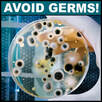WebMD Feature Archive© 2002 WebMD, Inc. All rights reserved.
Perhaps Ally McBeal can ease her off-the-charts stress levels by escaping to the office restroom. But for most of us, public toilets are actually a bit scary ...
If you squirm at the thought of creepy germs lurking on toilet seats and faucet handles, you probably spend as little time as possible in the restrooms of your office building, not to mention those in restaurants, hotels and (God forbid!) gas stations. And during those nerve-wracking moments when you dare to venture into the confines of the bathroom, you may find yourself pushing open the stall door with your elbows, crouching precariously above the toilet seat rather than letting your skin touch it, and flushing with your shoe ...
But while there's plenty of bathroom paranoia to go around, anxiety might be a little overdone. Yes, there can be plenty of bugs lying in wait in public restrooms, including both familiar and unfamiliar suspects like streptococcus, staphylococcus, E. coli and shigella bacteria, hepatitis A virus, the common cold virus, and various sexually transmitted organisms. But if your immune system is healthy, and if you adopt simple hygienic measures like handwashing, you should be able to deliver a knockout punch to most of what you encounter ...
Germs in feces can be propelled into the air when the toilet is flushed. For that reason, Philip Tierno, MD, director of clinical microbiology and diagnostic immunology at New York University Medical Center and Mt. Sinai Medical Center, advises leaving the stall immediately after flushing to keep the microscopic, airborne mist from choosing you as a landing site ...
Other hot zones in public bathrooms include sinks, faucet handles, and towel dispensers. Picture someone emerging from a bathroom stall, and turning on the faucet with dirty hands, and you'll know why faucet handles are a potentially troublesome surface. Studies at the University of Arizona in Tucson found that sinks are the greatest reservoir of germ colonies in restrooms, thanks in part to accumulations of water that become breeding grounds for tiny organisms ...
Read full article published by WebMD.com
 RSS Feed
RSS Feed






